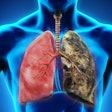
Scientists at Northwestern Medicine have identified and described a gene responsible for activating an aggressive subtype of small-cell lung cancer (SCLC) known as the P subtype. The findings were published Wednesday in Science Advances.
Lung cancer is the leading cause of cancer mortality in the U.S. Despite recent advances in screening and management, it is still often diagnosed at later stages, which plays a considerable role in the high mortality of the disease. SCLC accounts for around 13% of all lung cancers.
According to lead study author Lu Wang, an assistant professor of biochemistry and molecular genetics at Northwestern University Feinberg School of Medicine, 70% of cases of SCLC are diagnosed at late stages, after it has spread to other parts of the body, making it harder to treat.
The SCLC-P subtype is particularly aggressive, and its primary treatment is chemotherapy. Most patients develop chemoresistance, limiting the efficacy of therapy and often leading to recurrence.
“It’s devastating to patients and their families when we tell them there is no effective treatment for this type of cancer,” said Wang, who is also a member of the Robert H. Lurie Comprehensive Cancer Center of Northwestern University.
Through genome-wide CRISPR screening, Wang’s team identified a previously uncharacterized gene, C11orf53, which was expressed in both SCLC cell lines and patient samples. C11orf53 encodes for a 288-amino acid protein product without any known functional domain or cellular localization signal. In the study, C11orf53 was identified as a coactivator of POU2F3, a key regulator that has been used as a biomarker for the P subtype.
The researchers determined that C11orf53, which they have named POU Class 2 Homeobox Associating Factor 2 (POU2AF2) due to its interactions and characteristics, is essential for the survival of SCLC-P subtype tumors. When the team deleted POU2AF2 in SCLC cells in vitro and in mice, there was a loss of expression of POU2F3, leaving the cancer cells unable to survive.
However, according to the authors, about 32% of POU2AF2-targeted genes were not affected when POU2F3 was depleted, suggesting that POU2AF2 may have an additional function independent of POU2F3. The findings showed that a significant proportion of POU2AF2 proteins were present in the cytoplasm, while POU2F3 was mostly detected in the nuclei. The researchers noted that identifying the cytoplasmic function of POU2AF2 merits future study.
To develop an effective treatment for SCLC-P subtype, Wang’s team plans to develop a drug to disrupt the functioning of the POU2AF2 gene. Furthermore, because of POU2AF2’s specificity to the subtype, it may serve as a biomarker, leading to earlier diagnosis.
“Our ultimate goal is to implement a more personalized approach to small-cell lung cancer clinical treatment by targeting mechanisms that contribute to tumor growth based on factors that regulate molecular subtypes,” said Wang.



















